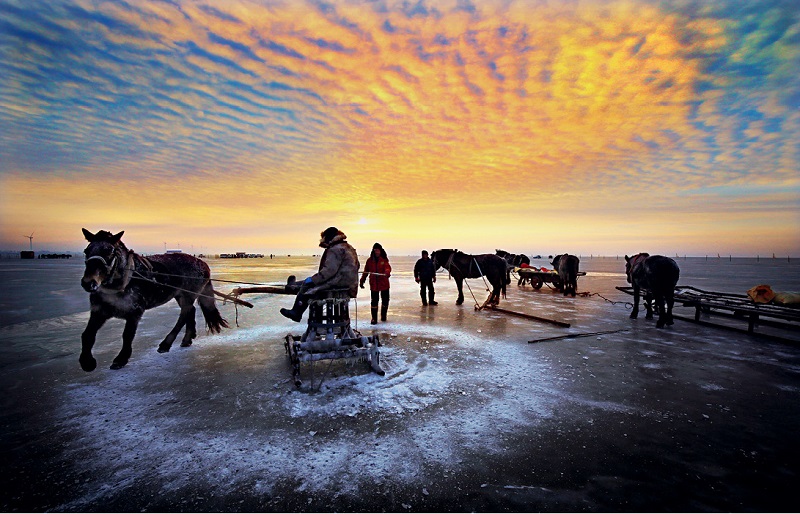
Fishermen are working on the frozen surface of the Chagan Lake.
The Chagan Lake, which means “a white holy lake” in Mongolian, lies in Qian Gorlos Mongol Autonomous County in Songyuan City of Jilin Province. With a span of 420 square kilometers, it is one of the largest freshwater lakes in China, one of the largest inland lakes in Jilin Province — and famous for its bighead carp, common carp, and silver carp.
Every year, from the end of December to the Spring Festival (in January or February), it is the prime time for the fishermen of Lake Chagan to engage in large-scale winter fishing. It has been an age-old tradition practiced there dating to the Liao Dynasty (916-1125). Its long history and unique technique earned it a spot on the list of national intangible heritage items in 2018.
During winter fishing season, fishermen at Chagan Lake set out at four in the morning clad in thick wool coats and hats. The fishing team is usually comprised of a leader, a group of fishermen, and several horses. The leader is traditionally an older, seasoned fisherman, and is referred to in the Mongolian language as “a hero fisherman.” Arriving at the intended location, the team quickly gets to work following the leader’s instructions. Spotting ice, drilling ice, setting nets, and collecting nets are the four key parts of winter fishing.
Since the river is wide, fishermen must examine the ice carefully to choose an ideal spot to catch fish. After the lake is frozen in winter, fish usually gather in groups. The gathering of fish usually creates a discernible surge of water underneath the ice, along with a slight elevation of the snow on the ice. Seasoned fishermen can find the location of the fish by those features. The color of the ice and the sound beneath the ice help to identify the spot.
The next step is drilling into the ice. First, the lengths of the fishing holes and their intervals are measured. Then, fishermen start to drill around 100 holes with specialized gear. The first hole is usually 1.5 meters wide. After that, they start to set a large net that is one kilometer long by spreading the net with rods under the ice to each hole. After more than two hours, like threading a needle, the net is finally set underwater.
The last step is pulling the net with a horse-drawn capstan. The net breaks through the ice and slowly surfaces while four sturdy horses pull the winches around.
Winter fishing in the Chagan Lake lasts from the end of December to the end of February, and nearly 1.5 million kilograms of fish are caught and sent to other places in China. Nowadays, winter fishing in the region has adopted the philosophy of sustainable development by using the large mesh net to let the small fish out, so that the fish in the Chagan Lake get replenished every year and the esteemed fishing culture can be passed on from generation to generation.